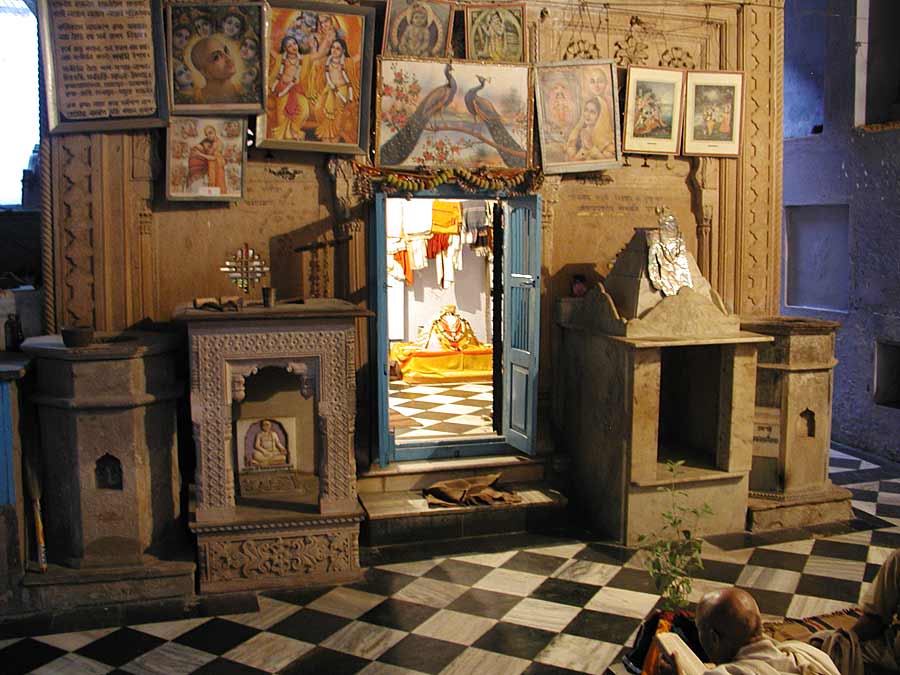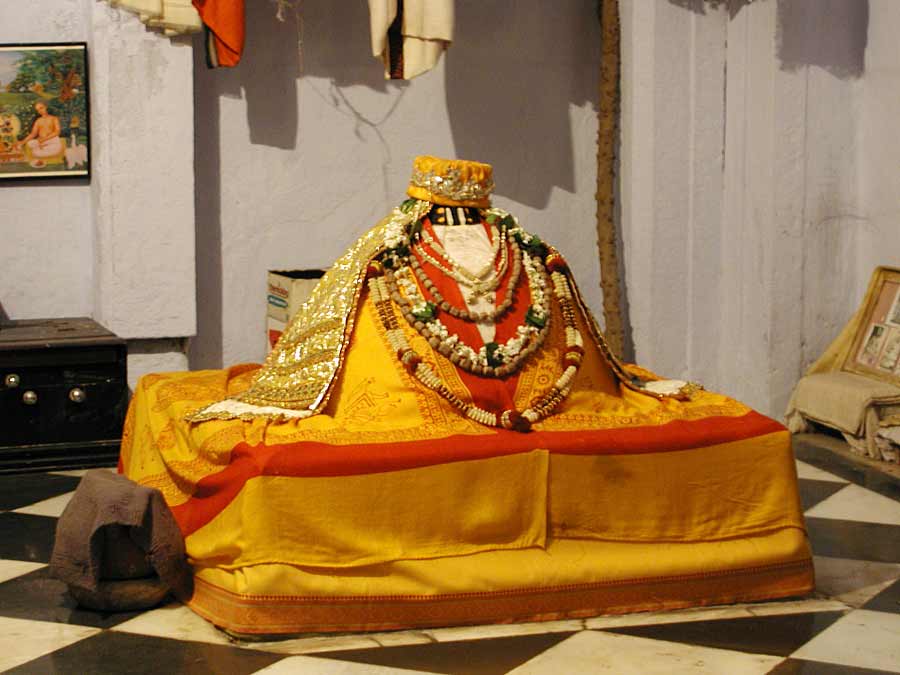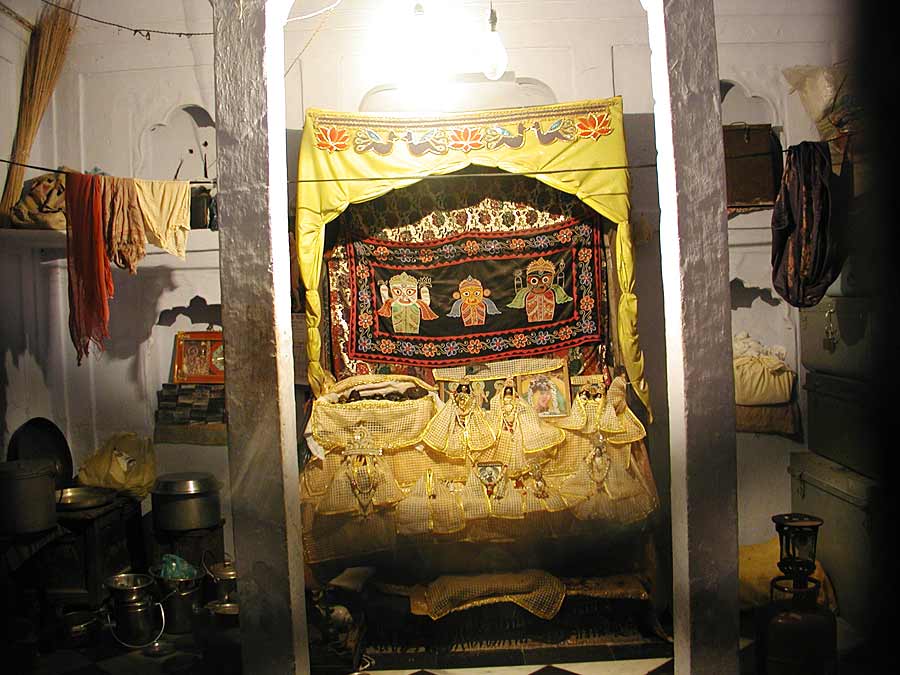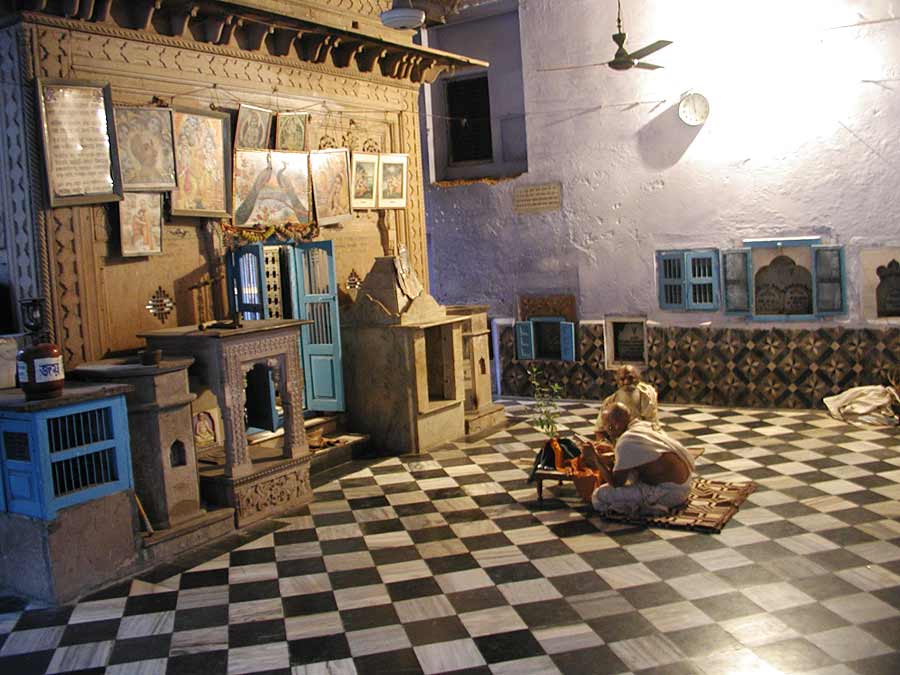 The all merciful Lord Sri Gaur Hari, as He travelled from village to village throughout the south of India, continued to distribute love of Godhead wherever He went. Hearing the nectarean names of Hari from His lotus mouth, thousands and thousands men and women felt relief from the blazing fire of material existence. Various wretched, miserable and fallen souls lives were completely rejuvenated and thus they became virtuous and happy. While causing rains of love of God to fall anywhere and everywhere, without consideration of time or place, Sri Gaurasundor came to the ancient holy place of Sri Rangakshetra on an island in the middle of the Kaveri river.
The all merciful Lord Sri Gaur Hari, as He travelled from village to village throughout the south of India, continued to distribute love of Godhead wherever He went. Hearing the nectarean names of Hari from His lotus mouth, thousands and thousands men and women felt relief from the blazing fire of material existence. Various wretched, miserable and fallen souls lives were completely rejuvenated and thus they became virtuous and happy. While causing rains of love of God to fall anywhere and everywhere, without consideration of time or place, Sri Gaurasundor came to the ancient holy place of Sri Rangakshetra on an island in the middle of the Kaveri river.Sri Gopala Bhatta Goswami was born on the day of the dark fortnight of the month Pausa in the year 1503 (Christian), 1425 (Saka).
He was the son of Vyenkatta Bhatta and Vamadevi, a brahmana resident of Sri Rangam, who was initiated in the Sri Sampradaya. The city of Sri Rangam is located on the Kaveri river in the district of Tanjor about ten miles west of Kumbhakonam.
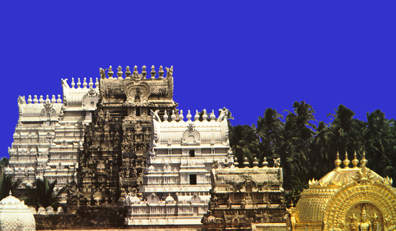
The temple of Sri Ranga Kshetra was extremely large, the crest of the temple tower pierced the sky. Throughout the day and night hundreds and thousands of pilgrims were going and coming to take darsan of Lord Ranganath. The temple hall resounded with the sounds of hundreds and thousand of brahmanas chanting Vedic hymns. In the midst of this scene from Vaikuntha, entered Sri Gaurasundar chanting the names of Krsna in his sweet voice that defeated the voices of 10 million gandharvas. Everyone in the temple became dumbstruck, amazed and thrilled with wonder. What unprecedented beauty; His bodily effulgence makes molten gold appear lack-lustre. From His eyes which are like the full blown petals of a lotusflower trickled down tears of ecstatic love. Every limb, every part of His body was filled with such exquisite grace that even the mind of cupid gets stolen away. The brahmanas began to consider, "Is this a demigod? Can such symptoms and emotions be found in human beings?" Again resounding the halls with the transcendental vibrations of Sri Hari's name, when He came before the Deity and fell down as a tree is blown down by the wind, some people thought that a mountain of gold was rolling on the ground. Sri Vyenkata Bhatta seeing this divine personage became restless with ecstasy. His heart being flooded with devotion he got up and began to move the crowds away so that the Lord could engage in chanting and dancing. When the Lord had regained His external consiousness after engaging in sankirtan, Vyenkata Bhatta approached Him and took the dust of His lotusfeet. Mahaprabhu gazed towards him and saying, "Krsna! Krsna!" embraced him firmly. Sri Vyenkata Bhatta invited Mahaprabhu to come to his house and having brought Him there, very reverantly washed His lotusfeet and along with the other family members, he drank the water. Sri Bhattaji's house became filled with joy.
Mahaprabhu came to Ranga Kshetra in the Christian year 1511. Vyenkata Bhatta had two brothers, Tirumalla Bhatta and Prabodhananda Sarasvati. They all belonged to the Ramanuja sampradaya and Prabodhananda Sarasvati was a tridandi sannyasi of that order. Vyenkata Bhatta had a son named Gopal, who was then just a child. When the boy came to offer his obeisances at the lotusfeet of Mahaprabhu picked him up and very affectionately seated him in His lap. Mahaprabhu would call Gopal after He had finished His meal and offer His remnants to the boy. In this way He prepared him for the positon of Acarya.
Sri Ranganath and Srimati Ranga-Nayaki utsav-vighraha at Sri Ranga-kshetra
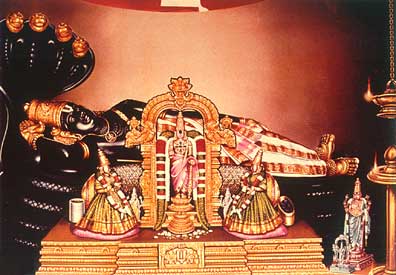
Sri Ranganath in Sri Rangakshetra
Gopala Bhatta studied rhetoric, poetry, Vedanta, and Sanskrit grammar from his uncle Prabodhananda Sarasvati. After the passing of his parents he went to Vrindavan, where he met both Rupa and Sanatana Goswamis as had puportedly been instructed in his vision.
Very quickly Gopal became expert in grammar, poetry and rhetoric and then began his study of Vedanta. His uncle Prabodhananda, specifically began to instruct him from the devotional scriptures (Bhakti - shastra).Gopal Bhatta always remained thinking of the lotus feet of Mahaprabhu and when he might again be able to meet Him. At the same time however he couldn't leave his aged mother and father. Finally having reached their final days they called their son Gopal and instructed him to go to the lotus feet of Mahaprabhu in Vrindavan. Then while meditating on His lotus feet themselves they went to join Him in His eternal lila.
At the age of thirty Gopala Bhatta Gosvami came to Vrindavana, and having missed Sri Caitanya Mahaprabhu this saddened him.
When Lord Chaitanya discovered that Gopala Bhatta was in Vrindavan, he was extremely pleased and sent some of his personal belongings to Gopala Bhatta, who worshiped them. Mahaprabhu also sent a letter instructing Gopala Bhatta to help Rupa and Sanatana compile Vaishnava literature. Gopala Bhatta accepted this instruction as his life and soul, and he later also engaged his disciple Srinivasa Acarya in carrying the writings to Bengal.
Thus Gopal set out for Vrindavan and when he arrived there Rupa Gosvami immediately sent word to Mahaprabhu to inform Him of Gopal's arrival there.Mahaprabhu had previously indicated to Rupa and Sanatan that Gopal Bhatta would one day come there to Brindavan, so upon his arrival they treated him with the same care and affection they would their own brother. They immediately became life long companions.
However, the all knowing Supreme Personality of Godhead, Sri Caitanya Mahaprabhu received word that Gopal Bhatta had come to Vrindavan, He was very pleased and sent with that messenger with the Lord's personal wooden sitting plank (hoki) which He had used along with a pair of His undergarments and one of His upper cloths - uttara or chaddar. "Having received these gifts Gopal Bhatta was in ecstasy and he worshipped them as the prasad (tadiya) of Mahaprabhu.
When he would worship his Deities he would sit on that wooden plank. This piri (wooden seat) and Mahaprabhus clothes are still being worshipped at Radha-Ramana Mandir. Gopala Bhatta, like Rupa and Sanatana, had no fixed residence and would spend the night in various kunjas (forest groves). He spent his time studying the scriptures and composing various literatures.
After Sri Caitanya Mahaprabhu's disappearance Gopala Bhatta Gosvami felt intence separation from the Lord. To relieve his devotee, the Lord instructed Gopala Bhatta in a dream :"If you want my darsan then make a trip to Nepal".
In Nepal, Gopala Bhatta bathed in the famous Kali-Gandaki River. Upon dipping his waterpot in the river, he was surprised to see several Shaligrama Shilas enter his pot. He dropped the shilas back into the river, but the shilas re-entered his pot when he refilled it.
After emptying and refilling his waterpot for the third time, Gopala Bhatta Gosvami found twelve Shaligrama shilas sitting there. Thinking this must be the Lords mercy, he kept all the shilas and returned to Vrndavana.
Sri Gopala Bhatta Gosvami used to worship twelve Shaligram silas. Wherever he would go he would bring them with him in a piece of cloth tied at the corner. One day a wealthy man (Seth) came to Vrndavana and offered Gopala Bhatta a variety of clothing and ornaments for his Shaligrams. Being very impressed with the Gosvami he wanted his darshan and to render some service which he presented in the form of some valuable cloths and ornaments. However, Gopala Bhatta couldn't use these for his round-shaped Shaligrams, so he advised the donor to give the Deity decorations to someone else, but the Seth insisted. Gopala Bhatta kept the cloths and ornaments with his shilas. While Gopala Bhatta Gosvami was absorbed in remembering how the half-man, half-lion form of the Supreme Lord had manifested from the pillar in Hiranyakasipu's palace, he prayed in transcendental lamentation to the Lord: "Oh my Lord, you are very merciful and always fulfill the desires of your devotees. I wish to serve you in your form, having arms and legs and blissful smiling face, with lotus eyes.... If I had a Deity then I would be able to decorate Him so nicely with these clothes and ornaments."
In the evening after offering some bhoga and arotika to his Shalagram shilas, Gopala Bhatta put them to rest, covering them with a wicker basket. Late in the night, Gopala Bhatta took a little rest and then, in the early morning went to take bath in the Yamuna river. Returning from his bath, he uncovered the Shalagramas in order to render the puja for Them, and saw amongst Them a Deity of Krishna playing the flute. There were now eleven shilas and this Deity. The "Damodara shila", had manifested as the beautiful three-fold bending form of tri-bhangananda-krishna. Floating in the ocean of ecstasy, he fell to the ground in order to offer his dandavats and then recited various prayers and hymns. This wonderful event of the appearance day of RadhaRaman happened on the day after Sri Nrisimha Chaturdasi, and is celebrated on that day accordingly. That day they offer 500 liters of milk for the Lord's pleasure and many other sweets and different things. The RadhaRaman temple has the highest standard of Deity worship in all of Vraj.
When Rupa and Sanatana Gosvamis as well as many other devotees received news of this miraculous event they came running to see the Lord. Gazing on the Lord's transcendental form, which bewildered all the living entities of the many various planets, they all bathed Him with their tears. This Deity whom the Gosvamis named, "Sri Radha-raman Deva" made His appearance on the full moon day of Vaisakha in the year 1542. Except for Vrindadevi, Sri Radha-Ramanaji is the only one of the original Deities of Vrindavana who never left to go to Jaipur. Sri Sri Radha-raman-ji is still being worshipped in Vrindavana near Nidhuban kunj in the compound of the temple.
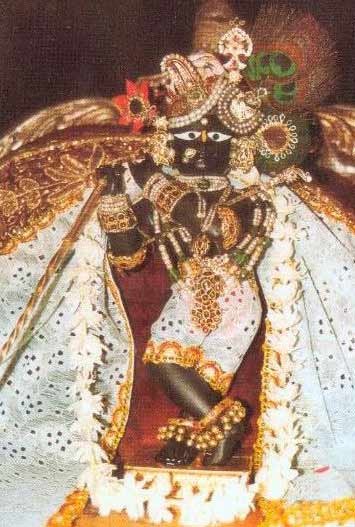
(In Pic:- Radha Ramanji - Svayumbhu deity given by Lord krishna to Gopal Bhatta Goswami who hailed from Srirangam )
The Deity is called Radha-raman although physically there is no apparent Deity of Radha there. As one can see from the picture at the top of this page, that to the right of the picture (to Ramanji's left) is a place setting for Srimati Radhika. In this way the pujaris worship Sri Radha and Ramanji together.
Sri Radha-ramana Deva, unlike other Deities, has very intricate features, including fingernails and even teeth. On the back side of His body parts of the original Shalagram shila from which He manifested Himself can be seen. There is a story that the small son of one of the sevaits was playing with the Deity once and put a small stick in one ear of the Deity and pushed it through out the other ear. The stick however, had blood on it, and that boy died vomiting blood that very day.
If you ever have the great good fortune to attend the Snan-yatra festival in Sri Vrindavan Dham, then it is a must that you visit the Radha-Raman temple on this day. The temperatures are hot and dry in the 40+ centigrade and much anticipation of seeking out cooling water pervades the thoughts in Vrindavan's hot summer. At the temple, the merciful Ramanji has made a provision so that first He takes His transcendental bath right at the front of the altar for all to see - BUT THEN, after He has taken in His expanded kindness the pujaris turn on the sprinkler system that surrounds the open court-yard - the fan in the middle is even equipped with pipes to pour out cooling water as it rotates at a high speed, inundating all the devotees taking the darshan of the Lord, with great pleasure.
It is truly my favourite place in the world for snan-yatra. Sri Sri Radha Ramaji ki jaya.
In some discussion with the present day guardians of the temple and Deity, they told me that some scientists had come to examine the Deity and propound their doubts that He was self manifested, as the devotees state. They examined the Deity under the supervision of the devotees, but could find no evidence of carving.
About todays descendents: Once Sri Gopala Bhatta went to Haridwar. As he was returning, suddenly a downpour started and thus he took shelter in the house of one brahmana. This brahmana was very devoted and he very carefully began to serve Sri Gopala Bhatta, who thus became very pleased. As this brahmana had no children Sripad Gopal Bhatta Goswami blessed him that he might have a son who would be a devoted follower of Lord Hari. The brahman replied out of gratitude that, "My first son I will send to you in order to serve you."
Approximately ten years later when Gopala Bhatta returned from bathing in the Yamuna one day, he saw a young boy sitting at the door of his kutir. When the boy saw the Gosvamiji approaching, he got up and then fell down to offer his dandavats (obeisances like a stick on the floor before him). Sripada Gopala Bhatta Goswami enquired who the boy was, to which he replied, "My home was in Devandyagram within Saharanpur near Haridwar. My father has sent me here to serve you. My name is Gopinatha."
Then Gopal Bhatta could remember the time when he went to Haridwar many years ago. So this boy remained with him and very carefully began to serve him. Eventually he became known as Sri Gopinatha Pujari Gosvami as he served Sri Radha-ramana Deva through his life as an unmarried brahmachari. His younger brother Sri Damodara dasa, along with his family, accepted iniation from Sri Gopinathaji and also became engaged in the service of the Deity. Sri Damodara dasa's three sons were named Harinatha, Mathuranatha and Harirama. It is from these family members of Gopinath's brother that todays guardians the Radha-Raman Gosais so nicely maintain and serve Sri Sri Radha-Ramanji.
Sri Gopala Bhatta's devotion was so special, his devotion so profound that the Lord appeared for him in this special form - but not only that as if in confirmation of the pastimes of the Lord, and Mahaprabhu's being directly Radha Krishna (sri krishna chaitanya radha krishna nahi anya), in his worship of Sri Radha-ramana would sometimes see that He had taken the form of Sri Gaurasundara - Sri Chaitanya Mahaprabhu, "Becoming subservient to the love of Sri Gopala Bhatta, Sri Radha-ramana would sometimes accept the form of Sri Gausundara."
Sri Gopala Bhatta was the initiating guru of Srinivasa Acarya Prabhu. Sripad Gopal Bhatta Goswami was very learned, trained in pancharatra, coming in the learned family of Vyenkata Bhattar in the Sri Vaishnava line - he wrote many books including: Sat-sandarbha karika, Sri Krsna-vallabha (Krsna karnamrtatika), Sat kriya sara dipika (a brilliant work on Vaishnava samkara viddhi), and Laghu Hari-bhakti vilasa with Dig darshini tika. From this work, Sri Sanatana Gosvami compiled the Hari-bhakti-vilasa now followed by all Gaudiya Vaishnavas. It is said, "Out of affection for Srila Gopala Bhatta Gosvami, Srila Sanatana Gosvami compiled the famous Vaishnava smriti titled Hari Bhakti Vilas, and published it under Gopala Bhatta Gosvami's name.
Gopala Bhatta Gosvami resided for forty-five years in Sri Dham Vrndavana, but out of great humility he requested Srila Krsna das Kaviraja not to mention his name in the classic work Sri Chaitanya Charitamrita.
Gopala Bhatta Gosvami serves as Guna Manjari. In the Gaura-ganoddesa-dipika too, it is mentioned that in the eternal pastimes of Radha and Krsna, Gopala Bhatta Gosvami's name in Vraja-lila has been given as Guna manjari.
His disappearance was on the sixth day of the dark fortnight of the month of Sravon in the year 1578 (Christian - A.D.), 1500 (Sakabda era) Age: 75 years
Gopal Bhatta Goswami's Samadhi
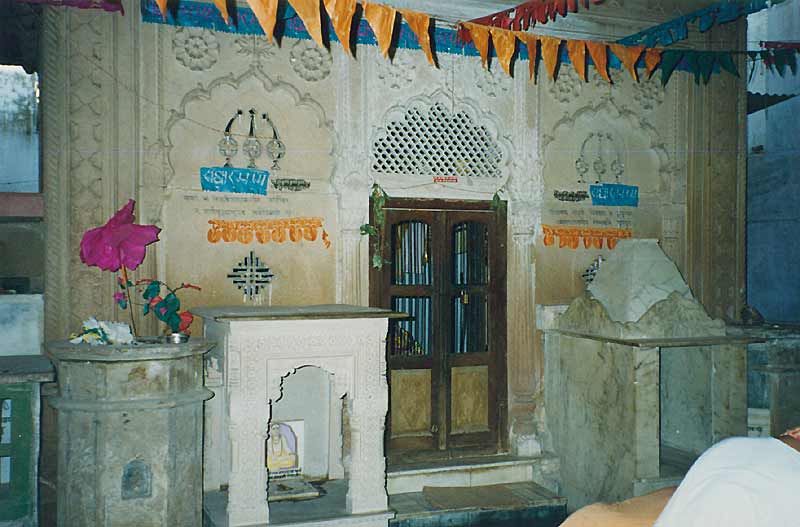
Gopal Bhatta Goswami's samadhi is to the left after you enter the first gate from the street into the temple compound. Gopal Bhatta Goswami was the son of Vyenkatta Bhatta, a brahmana priest of Srirangam Temple in Tamil Nadu. His uncle Prabhodananda Sarasvati also became his spiritual master. In 1511 Sri Caitanya Mahaprabhu visited Srirangam a danced in ecstasy before Lord Ranganath...
